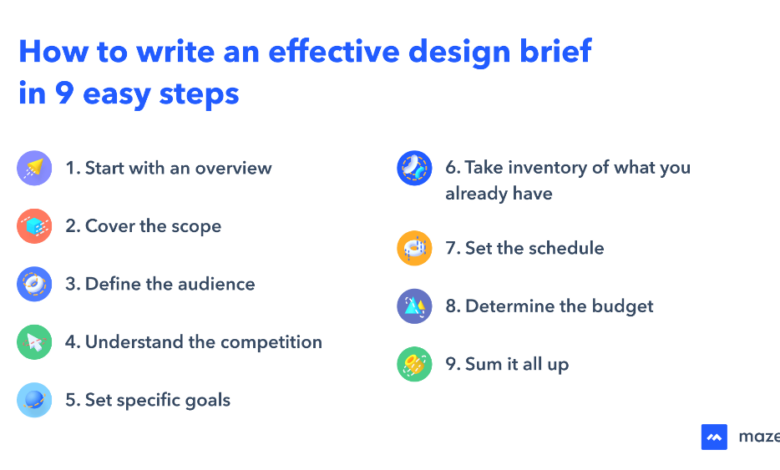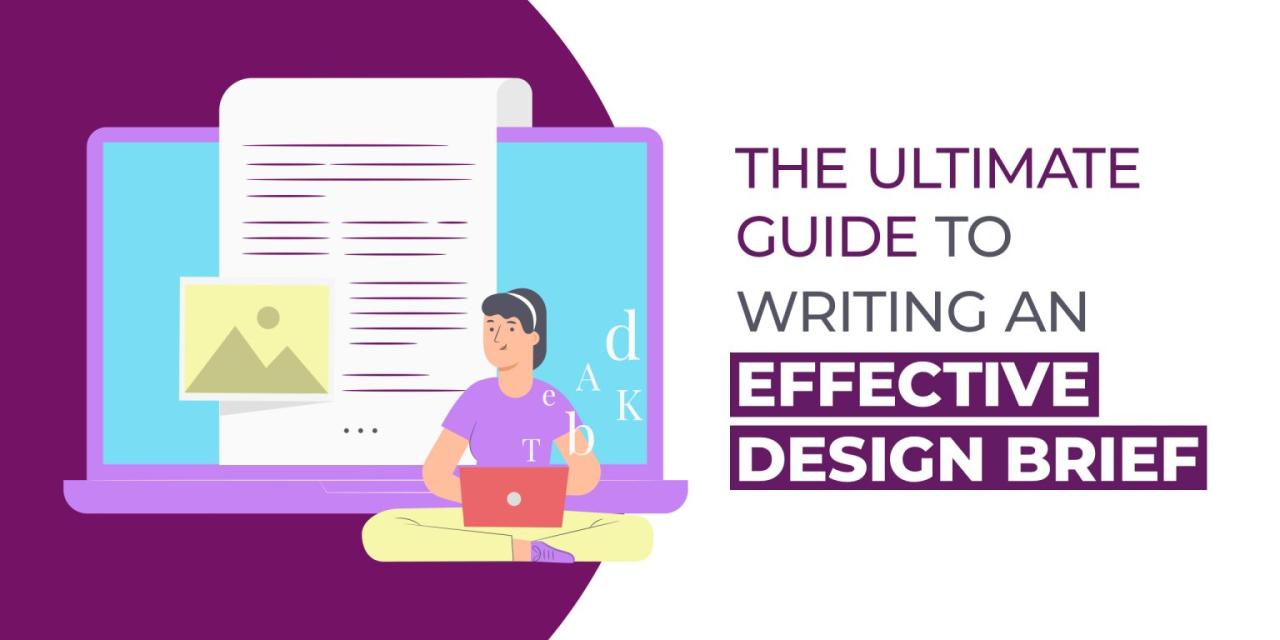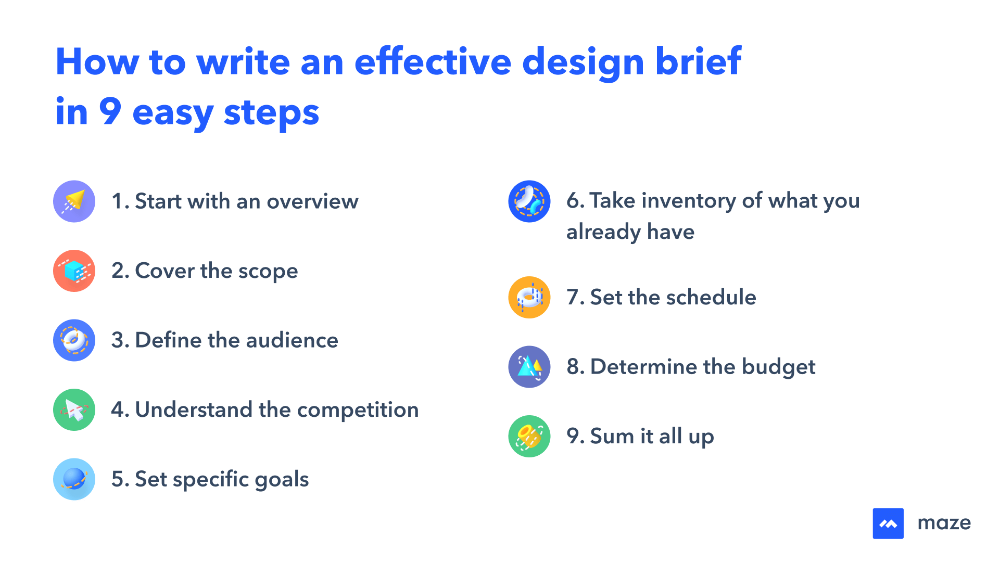
How to Write a Design Brief
How to write design brief – How to write a design brief? It’s more than just jotting down ideas; it’s the cornerstone of any successful design project. A well-crafted brief ensures everyone – from the client to the designer – is on the same page, leading to a smoother process and a final product that truly meets expectations. This guide breaks down the essential steps, from understanding the project’s core goals to setting realistic budgets and timelines.
We’ll explore the crucial components of a comprehensive design brief, offering practical examples and tackling common challenges. Learn how to effectively gather client information, translate their vision into actionable design requirements, and navigate potential disagreements. By the end, you’ll be confident in creating briefs that set your projects up for success.
Understanding the Purpose of a Design Brief: How To Write Design Brief
A design brief is more than just a list of requests; it’s the bedrock of any successful design project. It acts as a contract, a roadmap, and a shared understanding between the client and the designer, ensuring everyone is on the same page from the outset and minimizing costly revisions and misunderstandings down the line. Think of it as the blueprint for a beautiful building – without it, the construction is chaotic and likely to fall short of expectations.A well-structured design brief clearly articulates the project’s goals, target audience, and desired outcomes.
It provides the designer with the necessary context to create effective and relevant designs, while giving the client a clear picture of what they can expect. This shared understanding fosters collaboration and trust, leading to a smoother and more efficient design process.
Core Components of a Design Brief, How to write design brief
A comprehensive design brief typically includes several key elements. These elements work together to paint a complete picture of the project’s requirements and expectations. Missing even one component can lead to ambiguity and potential problems. For example, a lack of defined target audience can result in designs that fail to resonate with the intended users. Similarly, unclear objectives can lead to designs that miss the mark entirely.
- Project Overview: A concise summary of the project, its purpose, and its overall goals.
- Target Audience: A detailed description of the intended users, including their demographics, psychographics, and needs.
- Objectives: Clearly defined, measurable goals that the design should achieve. These should be SMART (Specific, Measurable, Achievable, Relevant, and Time-bound).
- Key Messages: The core messages or ideas that the design should communicate.
- Design Preferences: Any existing branding guidelines, style guides, or design preferences that should be followed.
- Scope and Deliverables: A clear Artikel of what is included and excluded from the project, along with the expected deliverables.
- Timeline and Budget: Realistic deadlines and a clear budget allocation for the project.
Benefits of Using a Design Brief
The benefits of using a well-written design brief are numerous and extend to both the client and the designer. For clients, it provides a sense of control and ensures their vision is accurately represented. For designers, it provides clarity, direction, and a framework for creative exploration. This shared understanding minimizes the risk of costly revisions and misunderstandings.
- For Clients: Clear communication, reduced risk of misinterpretations, better control over the design process, increased project efficiency, and a higher likelihood of achieving desired outcomes.
- For Designers: Clear direction and understanding of the project goals, reduced ambiguity, more efficient workflow, improved client satisfaction, and a stronger foundation for creative solutions.
Different Approaches to Writing Design Briefs
There isn’t one single “right” way to write a design brief. However, some approaches are more effective than others. Some briefs might be highly detailed and formal, while others might be more concise and informal. The best approach depends on the project’s complexity, the client’s preferences, and the relationship between the client and the designer. For instance, a large-scale branding project would require a far more comprehensive brief than a simple logo design.
Examples of Poorly Written Design Briefs
A poorly written design brief often lacks crucial details or is riddled with ambiguity. For example, a brief that simply states “design a website” is completely inadequate. It lacks specifics on the target audience, the website’s purpose, the desired functionality, and the overall aesthetic. Another example would be a brief that sets unrealistic deadlines or a budget that is insufficient for the scope of work.
These shortcomings lead to frustration, delays, and ultimately, a subpar final product. A brief that uses vague terms like “modern” or “creative” without further explanation leaves too much room for interpretation and can lead to widely different results than the client envisioned.
Gathering and Presenting Client Information

Source: digifloat.io
Crafting a killer design brief hinges on effectively gathering and presenting client information. This isn’t just about asking questions; it’s about building a shared understanding and translating vague desires into concrete design requirements. A well-structured process ensures everyone’s on the same page from the start, minimizing costly revisions and misunderstandings down the line.
The key is to move beyond surface-level discussions and delve into the client’s underlying needs and motivations. This involves active listening, probing questions, and a systematic approach to information gathering. This process will not only inform the design brief but also build a strong client relationship based on trust and clear communication.
Client Information Gathering Process
A structured approach to gathering information is crucial. This prevents missed details and ensures a comprehensive understanding of the client’s needs. Consider using a combination of methods to capture information effectively.
- Initial Consultation: This sets the stage. Discuss the project’s goals, target audience, and any existing branding guidelines. Use open-ended questions to encourage detailed responses.
- Questionnaire: A well-designed questionnaire provides a consistent framework for gathering essential information. Include questions about brand identity, target audience demographics, marketing objectives, budget, and deadlines.
- Competitor Analysis: Ask the client to provide information about their competitors. This helps understand the competitive landscape and identify opportunities for differentiation.
- Review of Existing Materials: Examine any existing branding assets, marketing materials, or website designs to gain insights into the client’s existing style and brand voice.
- Follow-up Meetings: Schedule follow-up meetings to clarify any ambiguities and address any emerging questions. This iterative approach ensures the brief accurately reflects the client’s vision.
Translating Client Needs into Actionable Design Requirements
Once you’ve gathered the information, the next step is to transform those client needs into concrete design requirements. This involves careful analysis and a focus on creating specific, measurable, achievable, relevant, and time-bound (SMART) goals.
For example, instead of a client saying “I want a modern website,” the design brief should specify things like “The website must be responsive, load in under 3 seconds, and utilize a minimalist design aesthetic with a focus on clean typography and high-quality imagery.” This level of detail provides a clear roadmap for the design process.
Crafting a killer design brief starts with clear objectives. Think about your target audience and desired outcome; for visual inspiration, check out Grafex Media’s awesome guide on getting it on with youtube , it’s packed with great examples of successful video marketing. Then, translate that visual appeal into your design brief’s specifications, ensuring your team understands the vision perfectly.
Challenges in Communicating with Clients and Solutions
Communication breakdowns are inevitable. However, proactive measures can minimize these challenges. Understanding potential obstacles and developing solutions is key.
- Challenge: Clients may lack a clear understanding of design principles or terminology.
- Solution: Use clear, concise language, avoiding jargon. Visual aids, such as mood boards or style guides, can effectively bridge communication gaps.
- Challenge: Clients may have unrealistic expectations regarding timelines or budgets.
- Solution: Clearly Artikel project timelines and budget constraints upfront. Manage expectations by providing realistic estimates and explaining the process involved.
- Challenge: Clients may provide conflicting or changing requirements.
- Solution: Establish a clear communication protocol, including regular check-ins and documented feedback. Maintain detailed records of all communication and decisions.
Incorporating Client Feedback Effectively
Client feedback is invaluable. However, managing it effectively requires a structured approach.
Designate specific times for feedback sessions. Document all feedback received, noting the date, source, and context. Analyze the feedback objectively, separating constructive criticism from personal preferences. Communicate how the feedback has been incorporated (or why certain suggestions were not adopted) transparently and professionally. This process ensures that feedback is used constructively and strengthens the client relationship.
Visual Communication and Style Guide Elements

Source: designshifu.com
A well-defined style guide is crucial for ensuring visual consistency across all design deliverables. It acts as a blueprint, guiding the design process and ensuring the final product aligns perfectly with the client’s brand and the project’s objectives. This section Artikels the key components of a style guide within the design brief and how to effectively communicate visual direction.
The style guide section of a design brief acts as a visual contract, detailing the aesthetic direction of the project. It bridges the gap between client vision and designer interpretation, minimizing misunderstandings and ensuring a cohesive final product. Think of it as a shared language for visual communication.
Style Guide Section Representation
Imagine a table within the design brief. The first column lists elements like “Color Palette,” “Typography,” “Imagery Style,” and “Layout Grid.” The second column provides detailed descriptions. For “Color Palette,” this might include specific hex codes (#007bff, #dc3545, #28a745) and their corresponding names (e.g., primary blue, danger red, success green). “Typography” would list primary and secondary fonts (e.g., Open Sans for body text, Montserrat for headings), their weights (regular, bold, italic), and sizes for different headings and body text.
“Imagery Style” might describe the desired photographic style (e.g., clean and minimalist, vibrant and bold, vintage and textured) or illustrative approach (e.g., flat vector illustrations, hand-drawn sketches, photorealistic renderings). Finally, “Layout Grid” would define the underlying structure for page layouts (e.g., a 12-column grid system with specific gutter sizes).
Visual Style Examples and Suitability
Different visual styles cater to different projects and audiences. A minimalist style, characterized by clean lines, simple layouts, and a limited color palette, is well-suited for technology companies aiming for a professional and sophisticated image. Conversely, a vibrant and playful style, utilizing bold colors, dynamic layouts, and quirky illustrations, might be perfect for a children’s product or a social media campaign targeting a younger demographic.
A rustic style, employing earthy tones, textured backgrounds, and handcrafted elements, could be ideal for a coffee shop or a craft brewery, evoking a sense of warmth and authenticity. The choice of style should always align with the brand’s personality and target audience.
Describing Aesthetics Without Visual Examples
While visual examples are helpful, effectively describing aesthetics without them is crucial. Instead of saying “make it look like this website,” focus on descriptive language that evokes the desired feeling and style. For example, instead of referencing a specific color, describe it as “a calming, serene blue reminiscent of a clear summer sky,” or describe a font as “a classic serif typeface that conveys elegance and trustworthiness.” Use evocative adjectives to describe the overall mood (e.g., modern, sophisticated, playful, rustic, edgy) and the desired visual impact (e.g., clean, bold, minimalist, intricate, organic).
Importance of Consistent Branding and Visual Identity
Maintaining consistent branding and visual identity is paramount. The design brief should clearly articulate the brand’s existing visual assets (logo, color palette, typography) and how the new design should integrate with them seamlessly. Inconsistency dilutes brand recognition and weakens brand messaging. A cohesive visual identity reinforces brand recall and builds trust with the audience. The style guide within the design brief ensures this consistency by providing a central repository for all visual elements and guidelines, preventing deviations from the established brand identity.
Setting Realistic Deadlines and Budget

Source: pinimg.com
Crafting a design brief that’s both ambitious and achievable hinges on setting realistic deadlines and a transparent budget. Without these crucial elements, your project risks delays, cost overruns, and ultimately, client dissatisfaction. This section will guide you through the process of establishing both, ensuring your design brief is a roadmap to success, not a recipe for disaster.
Defining realistic timelines and budgets requires careful planning and a deep understanding of the project’s scope. It’s not simply about throwing numbers together; it’s about creating a framework that allows for flexibility while maintaining a clear path towards completion. This involves breaking down the project into manageable phases, assigning specific tasks to each phase, and estimating the time and resources required for each task.
Sample Project Timeline
Let’s imagine a website redesign project. A realistic timeline might look something like this:
| Phase | Milestones | Duration |
|---|---|---|
| Discovery & Planning | Client briefing, site audit, competitor analysis, wireframing | 2 weeks |
| Design | Homepage design, internal page designs, style guide creation | 3 weeks |
| Development | Front-end development, back-end development, content migration | 4 weeks |
| Testing & Launch | QA testing, bug fixing, launch | 1 week |
This timeline provides a clear picture of the project’s progression, allowing for better management and tracking of progress. Remember, these are estimates and can be adjusted based on project complexity and unforeseen circumstances.
Strategies for Setting Realistic Deadlines
Setting realistic deadlines is crucial for project success. Several strategies can help achieve this.
- Break down the project into smaller, manageable tasks: This allows for better estimation of time required for each component.
- Consider potential roadblocks and build in buffer time: Unexpected issues are inevitable; adding buffer time mitigates their impact.
- Consult with your team and client: Get their input on time estimates to ensure everyone is on the same page.
- Use project management software: Tools like Asana, Trello, or Jira can help track progress and manage deadlines effectively.
- Regularly review and adjust the timeline: Flexibility is key; adapt the timeline as needed based on progress and unforeseen events.
Creating a Transparent and Comprehensive Budget Breakdown
A transparent budget builds trust and avoids misunderstandings. It should clearly Artikel all costs associated with the project.
- List all project costs: This includes design fees, development fees, content creation costs, third-party tools, and any other expenses.
- Specify hourly rates or project fees: Be upfront about your pricing structure.
- Include potential additional costs: Artikel any potential extra charges for revisions or additional features.
- Provide a clear payment schedule: Artikel when payments are due and what each payment covers.
Budgeting Methods and Their Impact on Project Success
Different budgeting methods can impact project success. Two common methods are:
- Fixed-price budgeting: A fixed price is agreed upon upfront. This offers predictability but can be risky if the project scope changes significantly.
- Hourly/Time and Materials budgeting: The client pays for the time spent on the project. This offers flexibility but can lead to unpredictable costs if the project takes longer than expected.
Choosing the right method depends on the project’s complexity, the client’s risk tolerance, and your team’s ability to accurately estimate time and resources. A hybrid approach, combining elements of both methods, might be the optimal solution for some projects.
Review and Approval Process
Getting the design brief signed off is crucial; it’s the bedrock of a successful project. A well-defined review and approval process ensures everyone is on the same page, minimizing misunderstandings and costly revisions later on. This process should be clear, efficient, and leave no room for ambiguity.A structured review process ensures clarity and minimizes potential conflicts. It helps to prevent costly rework down the line by addressing potential issues early.
This not only saves time and money but also fosters a stronger client-designer relationship built on trust and transparency.
Design Brief Review Checklist
A comprehensive checklist is essential for a thorough review. This checklist should be used by both the client and the designer to ensure all necessary information is included and accurate. Missing details can lead to significant problems further down the line.
- Project Goals and Objectives: Are the project goals clearly defined and measurable? Are the objectives realistic and achievable within the given timeframe and budget?
- Target Audience: Is the target audience clearly identified, including demographics, psychographics, and their needs?
- Scope of Work: Are the deliverables clearly Artikeld? Does it specify exactly what will be designed and delivered?
- Timeline and Milestones: Are key deadlines and milestones clearly stated? Is the timeline realistic and achievable?
- Budget: Is the budget clearly defined, including any potential additional costs?
- Communication Plan: Is a communication plan established, outlining how and when the client and designer will communicate throughout the project?
- Approval Process: Is the approval process for design concepts and deliverables clearly defined?
- Intellectual Property Rights: Are the ownership rights of the design work clearly defined?
Handling Disagreements
Disagreements can arise, even with the most meticulously crafted brief. Establishing a clear process for handling these disagreements is vital for maintaining a positive working relationship. Open communication and a willingness to compromise are key.A structured approach to resolving disagreements might involve revisiting the original brief, discussing the points of contention, and exploring alternative solutions collaboratively. Involving a neutral third party mediator, if necessary, can be beneficial in reaching a mutually agreeable outcome.
Documentation of all discussions and decisions is crucial.
Importance of Clear Communication
Clear communication is the lifeblood of any successful design project. The review and approval process is no exception. Regular updates, proactive communication, and a willingness to listen to each other’s perspectives are crucial for a smooth process.For example, using project management software with integrated communication tools facilitates seamless collaboration. Regular meetings, both in-person and virtual, provide opportunities to address concerns and clarify any ambiguities.
Maintaining a detailed record of all communication helps prevent misunderstandings and ensures everyone is informed. Active listening and a willingness to adapt are also critical for successful communication. Ignoring issues or avoiding communication will almost certainly lead to problems later.
End of Discussion
Mastering how to write a design brief is an invaluable skill for anyone involved in the design process. By following the steps Artikeld here, you can ensure clear communication, manage expectations, and ultimately deliver exceptional results. Remember, a strong design brief isn’t just a document; it’s a roadmap to a successful collaboration and a stunning final product. So, ditch the vague ideas and embrace the power of a well-defined brief – your projects (and your sanity) will thank you for it!
FAQs
What if my client doesn’t have a clear vision?
Use open-ended questions to guide them. Explore their goals, target audience, and preferred aesthetics. Collaboratively develop the vision during the brief creation process.
How do I handle scope creep during the project?
Clearly define the scope in the initial brief. Establish a change order process for any additions or alterations beyond the original scope, including revised timelines and budgets.
How detailed should my design brief be?
The level of detail depends on project complexity. Aim for clarity and completeness, providing enough information for the designer to understand the project without being overly prescriptive.
What if the designer needs clarification during the project?
Establish clear communication channels (e.g., regular meetings, email updates) for ongoing discussions and to address any questions or ambiguities that may arise.
